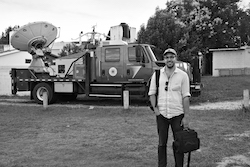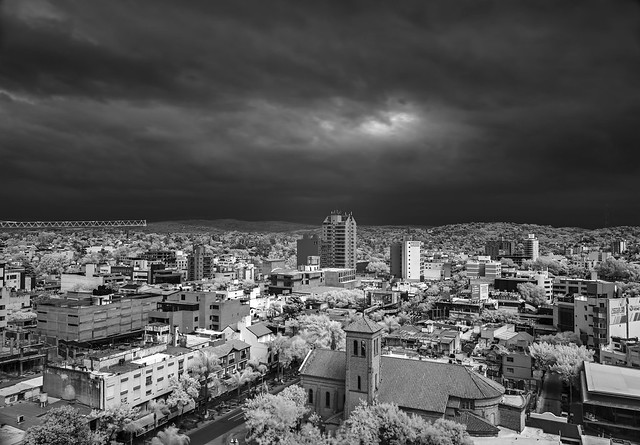SEJournal Online is the digital news magazine of the Society of Environmental Journalists. Learn more about SEJournal Online, including submission, subscription and advertising information.
Inside Story: Reporting on Storm Chasing’s ‘Human Side’ Hints at Climate’s Future
Chasing down megastorms with an international team of scientists led reporter Noah Gallagher Shannon to an understanding not just of painstaking and often dangerous fieldwork that goes into making a climate model, but also the very real toll the storms take on thousands killed or displaced by them. Below, Shannon details his project (may require subscription) for The New York Times Magazine, which won Outstanding Feature Story, Large, in the Society of Environmental Journalists’ 20th Annual Awards for Reporting on the Environment. Judges called his piece a work of “model journalism [that explains the phenomenon] through deep reporting, clear writing and a well-paced narrative." SEJournal Online recently caught up with Shannon. Below is a slideshow of images from the package by Mitch Dobrowner, followed by the edited conversation with Shannon.
SEJournal: How did you get your winning story idea?
Noah Gallagher Shannon: I noticed a press release about an international team of scientists gathering in a sleepy agricultural region in Argentina to study the megastorms that ravage the region. The setting, the team, the storms — it all seemed pretty obviously cinematic to me. And I thought it would be a compelling way to explore why some storms grow unexpectedly into disasters and how we can better model them in an increasingly uncertain future.
SEJournal: What was the biggest challenge in reporting the piece and how did you solve that challenge?
Shannon: Finding and getting close to a storm, no question. That was the question mark that kind of loomed over the whole project. Before I arrived in Argentina, the scientists had a run of extremely stormy weather down in Córdoba, with forecasts of more to come. But when I arrived in early December, I was greeted by day after day of beautiful, sunny weather. This turned out to be my first real lesson in storm chasing, that most of it is actually just sitting around in the truck and eating gas station food and waiting for something to happen. Which does put you in a kind of weird and uncomfortable ethical dilemma, one where you’re hoping for a destructive storm to form and close to you.
 |
| Shannon with the doppler on wheels. Photo: Mitch Dobrowner |
But once one did — and it turned out to be one of the largest in the area in some years — what I was most immediately struck by was the sheer logistical difficulty of what the scientists put into motion. In order to model and predict how a fast-moving, destructive phenomenon generates and behaves, let alone how one might generate and behave in a hotter and wetter future, they first had to chase it down. That is tough in a poorly mapped region of farm towns, where roads are sometimes unmarked, communications are limited and weather reports are all but nonexistent. Then they had to try to get sensitive instruments deep inside it, which is no easy task in the dark, in insane wind and rain, with hail and lightning striking all around you.
In comparison, my challenges — waiting for the storm, following the chasers — were fairly reasonable. And I don't think I really did anything to solve them, except to try to be patient and embrace them as part of the story.
SEJournal: What most surprised you about your findings?
Shannon: That storms could be that bad, be that violent or unpredictable, which told me I had no idea how bad they could get, now or in the future.
SEJournal: How did you decide to tell the story and why?
I could make it clear just how much of
modern civilization’s stability and abundance ...
comes down to a few people willing to chase a storm
and put themselves directly in its path of destruction.
Shannon: I felt like storm chasing alongside these scientists offered a cool and engaging way to narrate the painstaking and often dangerous scientific fieldwork that goes into making something as seemingly simple or banal as a weather forecast or climate model. It was my hope that by doing so, I could make it clear just how much of modern civilization’s stability and abundance — not just in the evasion of big disasters but also the preservation of little mundane comforts — comes down to a few people willing to chase a storm and put themselves directly in its path of destruction. That seemed really scientifically interesting and also just very human.
SEJournal: Does the issue covered in your story have disproportional impact on people of low income, or people with a particular ethnic or racial background? What efforts, if any, did you make to include perspectives of people who may feel that journalists have left them out of public conversation over the years?
Shannon: I knew, at least abstractly, that these storms weren't just exotic phenomena. Every year they kill or displace hundreds or thousands of Argentines, many of them poor farmers or those living in slums. Because of that I felt it would be fundamentally wrongheaded to narrate these storms as, like, a “scientific discovery," when locals had in fact been studying and trying to deal with them for decades. To that end, I tried to interview as many local farmers, meteorologists and government officials as I could — an effort aided by the scientists, who were themselves interested in what local knowledge could tell them about these storms and how they could help close the wide gulf in weather forecasting between the Global North and South. Watching this, I felt that my story should at least try to do something similar, to show the reader what these storms might tell us about the storms of the future in the United States, but also how forecasting, in many parts of the world, is still very crude and still very much a matter of life and death.
SEJournal: What lessons have you learned from your story?
Not to sound cliché, but one thing
this story really drove home for me was
the importance of true collaboration.
Shannon: Much of the writing and reporting of this story was a lesson in real time, like about how to stay patient when a story's out of your hands or how (if you're paying the right attention) the story itself often dictates the need for more or often left-out perspectives. So basically: everything. But more concretely, and not to sound cliché, but one thing this story really drove home for me was the importance of true collaboration. Watching how this big diverse group of scientists chased this huge violent fast storm was pretty cool and inspiring. And the photographer I was working with, the awesome and funny Mitch Dobrowner, and I tried to work in the same spirit — balancing the demands of photos and writing, trying to keep each other safe in some tough conditions, having a good sense of humor about brutally long days, etc. Hopefully Mitch would say the same, since I do think that stuff matters, even if it’s not often the riveting stuff of interviews.
SEJournal: What practical advice would you give to other reporters pursuing similar projects, including any specific techniques or tools you used and could tell us more about?
Shannon: Reporting and writing nonfiction is so often a sentence-by-sentence exercise in resourcefulness that I find it tricky to answer that in a super broad or helpful way. But one thing I did find invaluable in this story was the scientists' notes and field reports. Even though I was present for nearly everything I wrote about in this story, these notes and reports contained great little novelistic details and helpful scientific explanations, and were ultimately very useful in fact-checking.
Also, another thing: Always buy the insurance on your rental car if you’re going storm-chasing — just trust me.
SEJournal: Is there anything else you would like to share about this story or environmental journalism that wasn’t captured above?
Shannon: Just a big thanks to SEJ for recognizing my work. And to Willy Staley, my editor at The New York Times Magazine.
Noah Gallagher Shannon is a writer based in northern Colorado. He is a frequent contributor to The New York Times Magazine and winner of the 2021 AAAS Kavli Science Journalism Award for Excellence in Science Reporting. He is currently at work on a book for Random House about a group of young runners from East Africa who changed the sports world.
* From the weekly news magazine SEJournal Online, Vol. 7, No. 40. Content from each new issue of SEJournal Online is available to the public via the SEJournal Online main page. Subscribe to the e-newsletter here. And see past issues of the SEJournal archived here.













 Advertisement
Advertisement 



